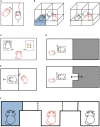Why help others? Insights from rodent to human early childhood research
- PMID: 37025110
- PMCID: PMC10070705
- DOI: 10.3389/fnbeh.2023.1058352
Why help others? Insights from rodent to human early childhood research
Abstract
Helping behavior are actions aiming at assisting another individual in need or to relieve their distress. The occurrence of this behavior not only depends on automated physiological mechanisms, such as imitation or emotional contagion, that is, the individual's emotion and physiological state matching with others, but also needs motivation to sustain. From a comparative and developmental perspective, we discover that the motivation for helping behavior has a deep foundation both phylogenetically and ontogenetically. For example, empathic concern for others, relieving personal distress and the desire for social contact are universal motivations across rodents, non-human primates and human early childhoods. Therefore, a circle-layered model integrating evidences for motivation for helping behavior from rodent to human early childhood research is proposed: the inner circle contains the emotional-behavioral system and the outer circle contains the affective-cognitive system. The application of this model has significance for both behavioral neuroscience research and cultivating prosocial behavior in human society.
Keywords: comparative cognition; helping behavior; human early childhoods; motivation; primates; rodents.
Copyright © 2023 Chen, Han and Yin.
Conflict of interest statement
The authors declare that the research was conducted in the absence of any commercial or financial relationships that could be construed as a potential conflict of interest.
Figures




Similar articles
-
Rodent models for studying empathy.Neurobiol Learn Mem. 2016 Nov;135:22-26. doi: 10.1016/j.nlm.2016.07.022. Epub 2016 Jul 28. Neurobiol Learn Mem. 2016. PMID: 27475995 Review.
-
Preschoolers' Helping Motivations: Altruistic, Egoistic or Diverse?Front Psychol. 2021 Apr 13;12:614868. doi: 10.3389/fpsyg.2021.614868. eCollection 2021. Front Psychol. 2021. PMID: 33927667 Free PMC article.
-
Helping behavior induced by empathic concern attenuates anterior cingulate activation in response to others' distress.Soc Neurosci. 2016;11(2):109-22. doi: 10.1080/17470919.2015.1049709. Epub 2015 Jun 2. Soc Neurosci. 2016. PMID: 26032190
-
Empathic Concern and the Desire to Help as Separable Components of Compassionate Responding.Pers Soc Psychol Bull. 2018 Apr;44(4):475-491. doi: 10.1177/0146167217741345. Epub 2017 Dec 4. Pers Soc Psychol Bull. 2018. PMID: 29202653
-
Behavioral and mechanistic insight into rodent empathy.Neurosci Biobehav Rev. 2018 Aug;91:130-137. doi: 10.1016/j.neubiorev.2016.06.007. Epub 2016 Jun 14. Neurosci Biobehav Rev. 2018. PMID: 27311631 Review.
Cited by
-
Life expectancy in ants explains variation in helpfulness regardless of phylogenetic relatedness.Behav Ecol. 2024 Dec 17;36(3):arae104. doi: 10.1093/beheco/arae104. eCollection 2025 May-Jun. Behav Ecol. 2024. PMID: 40134390 Free PMC article.
References
-
- Aknin L. B., Human L. J. (2015). Give a piece of you: Gifts that reflect givers promote closeness. J. Exp. Soc. Psychol. 60 8–16. 10.1016/j.jesp.2015.04.006 - DOI
Publication types
LinkOut - more resources
Full Text Sources

